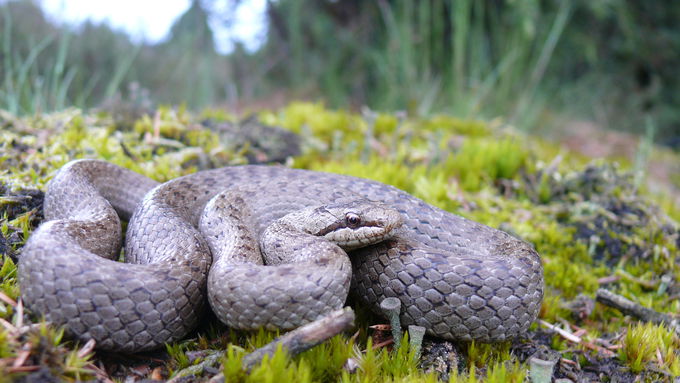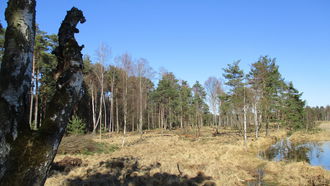Schlingnatter/Smooth Snake (Coronella austriaca) © Richard Podloucky
main content
Project of the month
#11/2017 Henneckenmoor in Celle
A Home for the Smooth Snake
The Henneckenmoor near Scheuen in the City of Celle is a 36 ha transition peat bog with extensively used or discontinued ponds and very distinct siltation areas. As the headwater of the “Vorwerker Bach”, it is situated in the geest of the northern part of Celle. The Natura 2000 site consists of patches of Sphagnum moss carpets and cotton grasses, wet heathland vegetation and relatively dry areas dominated by purple moor grass.
Five of the focus habitat types of the „Atlantic sand region“ are to be found here: natural dystrophic lakes and ponds (3160), Northern Atlantic wet heaths with Erica tetralix (4010), active raised bogs (7110), transition mires and quaking bogs (7140) and depressions on peat substrates of the Rhynchosporion (7150). In particular, this protected area is founded by the occurrence of the yellow-spotted whiteface (Leucorrhinia pectoralis) as well as the habitat types 3160 and 7140 within the physical region “Lüneburger Heide”.
Due to encroaching woodland growth, an area to the east of the aerodrome Celle-Arloh did no longer provide optimal habitat for the occurring smooth snake (Coronella austriaca). Its name is based on its smooth, keelless scales. Despite its sedentary lifestyle, the smallest of our native snake species lives very concealed and is considered to be the rarest snake in Lower Saxony. Due to the similar-looking markings, the smooth snake is commonly confused with the venomous European adder. An important distinctive feature is the pupils, which are circular in the smooth snake and vertically slit in the adder. Furthermore, adders have a much stronger zigzag colour pattern and tail and head are separated from each other more distinctively. Smooth snakes in contrast have a very variable marking with two matched or staggered rows of dark blotches on the back; in particular cases, they are even almost unspotted. The pattern of blotches on the back of the head and the back remain the same for their whole life and thus are very useful for lasting discrimination of individuals.
The smooth snake prefers well-structured habitats with a variation of single trees, loose shrubs as well as boggy and grassy areas without vegetation. Exactly these characteristics had been at risk to disappear in the Henneckenmoor. Therefore, there was an urgent need for action to provide the species-specific habitat for the smooth snake also in the future!
In the framework of the LIFE IP „Atlantic sand region“, therefore the overgrown area of the transition bog was cleared. This work was implemented in February 2017 in such a way that only 20-30 percent of the original shrubs remained. The deadwood was left on site to increase the number of structural elements. By means of this manual clearing the habitat of the smooth snake shall be upgraded and the usable area increased to a total of 5,600 square metres allowing the population of smooth snakes including accompanying species to stabilize and grow.
In the second phase of the LIFE IP species-specific monitoring shall follow up this activity to eventually elaborate and implement further required optimization measures. Only by this means it can be ensured that the smooth snake will find a permanent home in this area.





